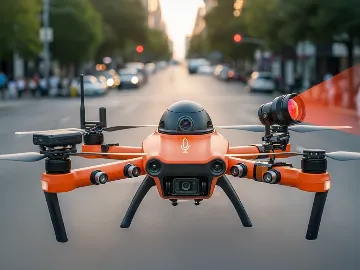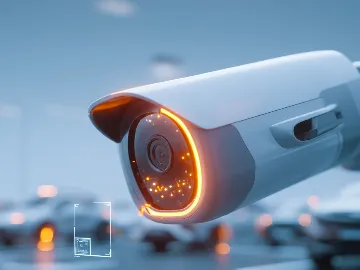As manufacturing complexities grow, industry leaders face inefficiencies in production, high operational costs, and stringent quality control requirements. According to IBM, 75% of these leaders now recognize Computer Vision (CV) as essential for achieving their business goals.
It's all about a different, smarter approach to every step of the process, including production, supply chain inventory management, and more. One of the goals is to create 'smart machines' that are able to see, communicate, and do the same work as humans with greater precision and better results.
Let's explore how Computer Vision use cases in manufacturing offer a feasible solution. Leveraging AI, Machine Learning, and Computer Vision systems can automate complex and repetitive tasks with reliable manufacturing software development, improve precision in quality assurance, and boost overall operational efficiency.
Computer Vision: Market overview
According to Gartner, the computer vision market is projected to grow at a 20.9% compound annual growth rate (CAGR) from 2023 to 2030. North America and Europe are leaders in the adoption of Computer Vision in manufacturing and several other industries. This growth is largely driven by its manufacturing applications, which are becoming integral in streamlining production lines and enhancing product quality.

Computer Vision is among the technologies digital transforming manufacturing. Other transforming technologies include AI and machine learning, advanced data analytics, automation and robotics, IIoT/IoT, autonomous systems, and next-generation ERP systems.
For instance, Ford has successfully implemented AI and Computer Vision in their production processes, achieving up to a 15% increase in assembly speeds. This integration automates repetitive and potentially dangerous tasks, reallocating human labor to more complex and impactful activities.
The Computer Vision market continuously transforms, creating new solutions and technological advancements. The industry is at the peak of the commercialization phase of Computer Vision development. CV is already utilized for applications such as facial recognition, content intelligence, recommendation engines, and more.
So why are companies around the globe investing in Computer Vision technologies?
Benefits of adopting Computer Vision in manufacturing

Increased productivity
Computer Vision systems facilitate nonstop operation and real-time assessments, drastically reducing production bottlenecks. They also enable quicker responses to production line issues, leading to a smoother flow of operations and significantly reducing cycle times.
Enhanced quality control
Advanced algorithms allow for precise detection of even the minutest deviations from product specifications, far beyond human capabilities. This precision ensures that products meet stringent quality standards, which is important in pharmaceuticals, automotive, and electronics industries.
Reduced cost
Automating routine and complex tasks reduces the reliance on human labor, particularly for repetitive or dangerous jobs, thus lowering payroll expenses. Moreover, by minimizing defects and errors, companies save on rework and scrap costs, enhancing financial efficiency.
Improved safety
Computer Vision systems can continuously monitor compliance with safety regulations and automatically detect unsafe behaviors or conditions. For example, they can identify workers who are wearing necessary safety gear and maintain safe distances from hazardous machinery.
Read more about prominent use cases of computer vision in security
More efficient data collection and analysis
Computer Vision systems' data can be analyzed to uncover inefficiencies and bottlenecks in the manufacturing process. This big data approach allows for predictive maintenance, where potential machine failures are identified before they occur, reducing unplanned downtime.
Enhanced customization capabilities
With Computer Vision, manufacturers can more easily customize products on the fly without slowing down the production process. This technology can quickly adapt to different product specifications, allowing for a more flexible production line that can handle a variety of products without significant downtime.
Environmental monitoring
Computer Vision can also monitor environmental conditions in manufacturing settings, such as temperature, humidity, or contamination levels. This monitoring helps ensure that conditions remain within the required parameters, which is important for maintaining product quality and safety.
How CV works in the manufacturing industry
Computer Vision in manufacturing uses cameras and artificial intelligence to understand and automate tasks based on visual data. Here's a breakdown of how it works:
- Cameras and sensors installed on manufacturing lines capture images and videos. These devices continuously collect visual data, including anything from the assembly process to the finished products.
- The collected visual data undergoes image processing, which is analyzed to identify relevant features or anomalies. This can involve enhancing images for clarity, filtering noise, or segmenting images into parts for easier analysis.
- The system uses Machine Learning, a type of Artificial Intelligence, to learn from the data. By applying algorithms, the system can automatically identify patterns or defects over time, improving its accuracy and efficiency in tasks such as quality control or part identification.
- After processing the data, the system uses its analyses to make decisions. For example, it might automatically reject a product that doesn't meet quality standards or adjust a machine's settings to optimize production.
- Finally, the outcomes of these decisions (like the effectiveness of a machine adjustment or the accuracy of defect detection) are used to train further and refine the machine learning models. This feedback loop helps the system adapt to new conditions or changes in the manufacturing process, continually improving its performance.
Read more: Computer vision quality inspection: How AI improves accuracy and compliance
Computer Vision applications in manufacturing: Top 8 use cases

While the actual applications of Computer Vision in manufacturing are almost limitless, let's focus on the key examples of how CV and ML can improve processes, increase productivity, and grow revenue.
Defect reduction
When many items need to be inspected on a production line, Computer Vision can be a superior technology that can help manufacturers automate this process. A complex CV solution can not only scan the item from several angles and match it to the acceptance criteria but also save the accompanying metadata. Why is it important? When the number of faulty items reaches XX, the system can inform the manager/inspector or even halt the production pending further inspection.
Detecting defects during the manufacturing process can be challenging, especially when dealing with small or subtle imperfections. Computer Vision systems accurately identify such defects, ensuring no defective product leaves the assembly line. This capability not only reduces production costs associated with waste but also maintains customer satisfaction by delivering consistently high-quality products.
Packaging inspection
Most manufacturers depend on a certain quality of their product, thus, having a system that can automatically find any deviations from the standard is essential. For example, a CV-based inspection can track whether an item has the desired color, length, and width, whether the edges are intact, if a package is filled to the necessary level, etc.
Computer Vision transforms packaging by improving accuracy, reducing costs, and optimizing operations. Amazon's Sparrow, the first robotic system in its warehouses, and DHL Parcel's collaboration with AWL for a robotic pick-and-place application showcase the impact of CV in enhancing packaging efficiency and reliability.
Barcodes scanning
Virtually every item being sold now has a barcode. Scanning those barcodes is not a task humans can do quickly and effectively on a large scale.
Technologies such as Optical Character Recognition (OCR), Intelligent Character Recognition (ICR), Optical Mark Recognition (OMR), and Barcode Recognition (OBR) facilitate the rapid scanning of texts and barcodes. These technologies enable real-time data analysis and are crucial for routing components on production lines, reading handwritten texts, verifying documents, and detecting checkboxes.
Automated assembly
As consumer demands for high-quality products increase, precision and consistency become paramount. Many businesses are turning to automation to address this, shifting repetitive tasks from human workers to machines. Computer Vision in manufacturing systems enhances these automated processes by merging the human eye's observational capability with computers' processing power.
Although automated systems provide significant advantages, the unique adaptability of human intelligence is irreplaceable in some contexts. For instance, Tesla, recognized for its highly automated manufacturing facilities, has shifted towards a more collaborative approach. This change came after realizing the limitations of a fully automated system; Tesla now integrates human workers with machines, optimizing productivity and innovation.
Predictive maintenance
Over time, heavy machinery and equipment can degrade, leading to potential faults and costly downtimes. Computer Vision technology facilitates continuous, accurate monitoring of these machines, alerting maintenance teams to potential issues before failures occur. When combined with IoT and deep learning, these predictive maintenance systems achieve high levels of accuracy and reliability. Major players in the oil and gas industry, such as Royal Dutch Shell, ExxonMobil, and Chevron, utilize these technologies to monitor equipment, preventing malfunctions and extending machinery lifespan.
3D vision monitoring
3D vision monitoring involves Сomputer Vision to create and analyze a 3D production process model. This technology is particularly useful in complex assembly lines, such as in automotive manufacturing, where it ensures components are fitted correctly. If a discrepancy is detected, the system immediately alerts engineers, preventing potential final product issues.
Quality inspection
Many manufacturers are shifting towards Computer Vision and deep learning for automated quality control and inspection. This technology minimizes human intervention, substantially increasing accuracy and efficiency. Computer Vision systems can inspect every item on the production line, unlike humans, who might sample randomly to ensure consistent quality.
Applications in mechanics involve surface inspections, defect detection, and damaged part identification using techniques like blob analysis and CNN segmentation. In the automotive sector, it's used for measuring surface characteristics and defect detection, while in 3D printing, it ensures quality through printhead calibration and defect identification.
Inventory management
Computer Vision transcends traditional stock-keeping by tracking the flow of materials from supply chain entry to the sale point. It enhances inventory management by providing rapid, error-free operations supported by data analytics, outperforming manual methods. Computer Vision in manufacturing industry optimizes inventory management by quickly locating items, counting stock accurately during transactions, identifying and rectifying misplaced stocks, and ensuring optimal warehouse space utilization.

Tips for successful implementation of Computer Vision in manufacturing
Successfully implementing Computer Vision in manufacturing requires strategic planning and careful implementation. Here are five expert tips to help ensure a smooth integration and maximize the technology's benefits:
Assess facility infrastructure
Before implementing Computer Vision, evaluate your existing infrastructure and IT capabilities. This assessment helps you understand the required upgrades or changes to accommodate new CV technologies. Computer vision consulting services also allow you to estimate the scope of work, select appropriate technologies that fit your current resources, and manage costs effectively.
Comply with legal and regulatory requirements
Manufacturing often faces stringent regulatory requirements, especially concerning data handling and privacy. Ensure compliance with all applicable laws regarding data collection, storage, and processing. This involves understanding local and international regulations that affect your operations and working closely with legal experts to implement compliant systems.
Develop a CV adoption plan
A well-structured plan is vital for seamless integration. A comprehensive computer vision implementation guide can help structure this plan, which should include a clear timeline, resource allocation, risk assessment, and contingency strategies. A detailed plan can help you manage changes more effectively and ensure that all aspects of the CV implementation are aligned with your business objectives.
Partner with an experienced technology vendor
Choosing the right technology partner is critical. A vendor with a strong track record in deploying Computer Vision solutions in manufacturing can provide invaluable expertise and insights. Look for a partner who not only understands the technical requirements but also has a deep familiarity with industry-specific challenges and regulations.
Ensure quality data input
The accuracy and reliability of Computer Vision in manufacturing systems depend heavily on the quality of data it receives. Invest in high-quality cameras and sensors to capture clear, high-resolution images. Additionally, ensure that the lighting and environmental conditions are controlled to avoid data corruption.
How can N-iX help you with Computer Vision for the manufacturing industry?
N-iX is a global software solutions and engineering services company with over 2,400 tech specialists who have experience working with business cases of different shapes and sizes. We have delivery offices across Europe and the Americas. Here's why you should opt for N-iX:
- We have strong technical expertise in Machine learning and AI, C/C++, Python, Java, .NET, Kotlin, DevOps, and QA.
- N-iX has a proven track record in delivering AI-based solutions to clients in various industries across the globe and one of the strongest expertise in machine learning in Ukraine.
Here's a glimpse of our success stories:
Our client is a German-based Fortune 100 engineering and technology company. To improve the logistics between 400+ warehouses, the client introduced a platform that turned out to be ineffective and unscalable. We delivered expertise in Industrial Computer Vision, Natural Language Processing (NLP), Embedded Computer Vision, Cloud-native Architecture, and Microservices Architecture.
- We transitioned to microservices architecture, facilitating the seamless integration of new AI-related services. These include anomaly detection, delivery prediction, route recommendations, object detection in logistics, optical character recognition (OCR) of labels on boxes, and Natural Language Processing.
- Our team enlisted a distinguished CV expert with a Ph.D. to lead the CV workstream. Following a meticulous analysis of existing algorithms, we opted for a complete redevelopment. This involved overhauling the solution's architecture and introducing Continuous Delivery for Machine Learning.
- We assisted in the design and development of a multiplatform Computer Vision mobile app from inception to execution. This comprehensive solution incorporates object detection, package damage detection, OCR, and NLP for document processing.
Furthermore, our proficiency extends to developing medical solutions for WEINMANN Emergency, an equipment manufacturer, where our dedicated team enhanced the MEDUCORE Standard² solution and expedited its release while ensuring compliance with rigorous healthcare regulations and policies.
Final thoughts
As you consider integrating Computer Vision into your manufacturing operations, it's essential to approach the adoption strategically. Starting with a well-defined pilot project, ensuring high-quality data input, integrating the system seamlessly with existing technologies, focusing on staff training, and working with experienced providers will pave the way for a successful implementation.
If you're ready to explore how Computer Vision can revolutionize your manufacturing processes, the N-iX team is here to help. We leverage advanced technologies to drive significant improvements across various industry sectors. Contact us today to discuss how Computer Vision can be tailored to meet your specific needs.
References:
- Computer Vision - IBM;
- Emerging Tech: Revenue Opportunity Projection of Computer Vision - Gartner.
Have a question?
Speak to an expert





